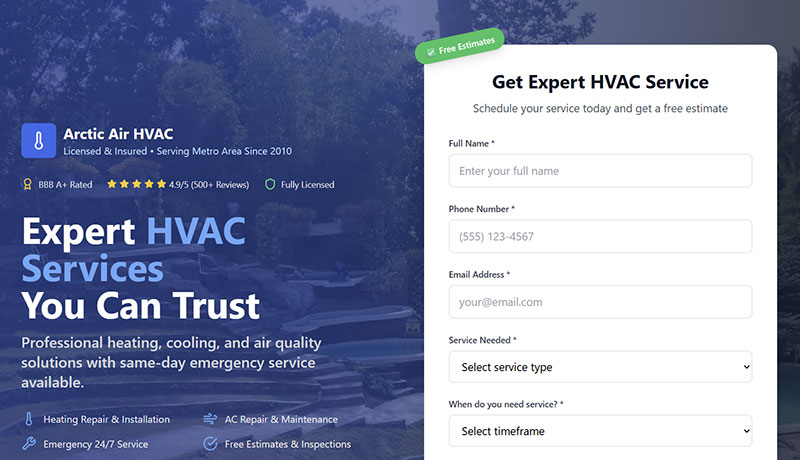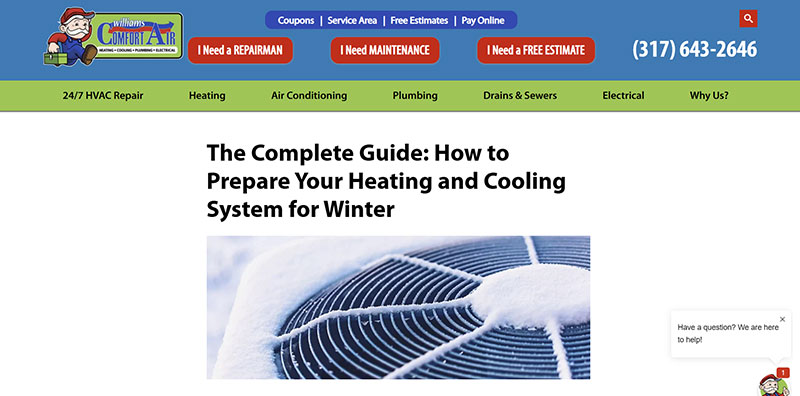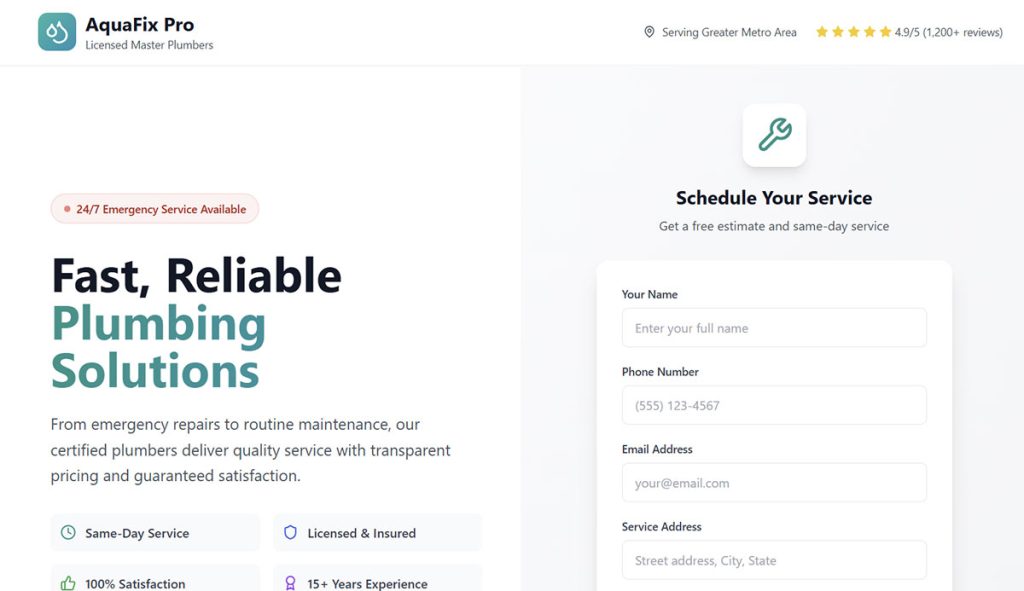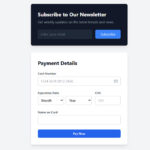Your sales team can’t close deals without qualified prospects in the pipeline. That’s the reality every B2B company faces. Lead generation for B2B companies determines whether your business grows predictably…
Table of Contents
Every contractor knows the feast-or-famine cycle. One month you’re turning down work, the next you’re scrambling to find customers.
Lead generation for contractors breaks this unpredictable pattern by creating consistent customer acquisition systems. Smart contractors use multiple marketing channels to maintain steady project flow regardless of seasonal demands.
This guide reveals proven strategies that generate qualified prospects year-round. You’ll discover digital marketing tactics that deliver immediate results, traditional methods that build long-term relationships, and tracking systems that maximize your marketing budget.
From Google Ads campaigns to referral programs, from direct mail to social media marketing, we’ll show you exactly how successful contractors build predictable sales pipelines.
By the end, you’ll have a complete roadmap for transforming sporadic inquiries into a thriving contractor business with consistent customer flow.
Digital Marketing Tactics That Work
The home services market continues expanding rapidly. From 2019 to 2026, the home services market is expected to grow by 18.91% each year, with the current market valued at $485 billion. This growth creates massive opportunities for contractors who embrace proven digital marketing strategies.
Search Engine Marketing
Google Ads delivers immediate visibility for contractors seeking qualified prospects. Set up campaigns targeting your service area with location-based keywords.
Google Ads dominates the PPC market with a 69.04% market share, and businesses typically earn $2 for every $1 spent, achieving a 200% ROI. Start with exact match keywords like “emergency plumbing repair” or “HVAC installation near me.”
These convert better than broad terms. Your advertising spend should focus on high-intent searches where homeowners need immediate help.
Key Performance Data:
- 65% of clicks on PPC ads come from users actively searching with intent to make a purchase
- Website visitors from PPC ads are 50% more likely to convert than those from organic efforts
Local Keyword Targeting Strategies
Target neighborhood-specific terms. “Roofing contractor downtown” beats generic “roofing services” every time.
Include seasonal keywords in your campaigns. “Furnace repair winter” captures emergency calls during peak demand periods. According to Google Ads, there are more than 1.2 million online searches for roofing services each month and more than 2.8 million online searches for plumbers each month.
Landing Page Creation for Campaigns

Create dedicated pages for each service. Your HVAC landing page shouldn’t promote plumbing services too.
Include customer testimonial videos on landing pages. Real homeowners talking about your work builds trust faster than written reviews.
Form design matters for conversions. Keep contact forms simple with just name, phone, and service needed. The 2024 overall average conversion rate of 6.96% demonstrates strong performance when campaigns are properly optimized.
Budget Management and ROI Tracking
Track customer acquisition cost by service type. Emergency calls typically justify higher ad spending than routine maintenance.
Set dayparting to show ads when you can answer phones. Missing calls from Google Ads wastes your marketing budget completely.
Monitor competitor activity through auction insights. Adjust bids when competitors increase their advertising spend during busy seasons. Small to mid-sized businesses invest between $1,000 and $10,000 per month in their Google paid search campaigns.
Content Marketing for Contractors
Content marketing significantly outperforms traditional advertising. Content marketing generates three times more leads per dollar spent than traditional advertising, and it costs 62% less.
Blog Topics That Attract Customers

Write seasonal maintenance guides. “Preparing Your HVAC System for Winter” gets shared by homeowners every fall.
Address common customer concerns directly. “How Much Does a New Roof Really Cost?” answers the question everyone’s thinking.
Create troubleshooting guides for simple fixes. You’ll still get calls for complex problems while building authority. Companies that maintain a blog see a 55% increase in website visitors and a whopping 97% more links directed to their site.
Video Content for Project Demonstrations
Film before and after transformations. Visual proof of your work quality beats written descriptions every time.
Show your team in action during installations. Homeowners want to see the actual people who’ll enter their homes.
Create short educational videos explaining when to call professionals versus DIY attempts. Video has become a preferred medium, delivering ROI 49% faster than text-based content.
Educational Content About Your Services
Explain industry terminology in simple language. Most homeowners don’t know the difference between furnace repair and replacement.
Share cost-saving tips that actually help customers. This builds goodwill and positions you as trustworthy.
Customer success stories work better than generic case studies. Real names and locations make testimonials credible. User-generated content, such as customer reviews and testimonials, see a 4.5x increase in conversion rates.
Customer Success Story Creation
Document complete project timelines with photos. Show the mess, the work process, and the finished result.
Include specific cost savings or efficiency improvements. Numbers make stories more compelling than vague benefits.
Get video testimonials during project completion when satisfaction runs highest.
Email Marketing Systems
Email marketing delivers exceptional returns for contractors. Email marketing generates an average ROI of $36-$42 for every $1 spent, translating to a 3,600-4,200% return on investment.
Newsletter Setup for Past Customers
Mailchimp or Constant Contact work well for most contractors. Start simple with monthly maintenance reminders.
Segment lists by service type. Pool maintenance customers don’t need HVAC tune-up reminders. Segmented emails drive 30% more opens and 50% more clickthroughs than unsegmented ones.
Follow-up Sequences for New Leads
Send immediate confirmation after lead generation form submissions. Speed matters more than perfect messaging.
Create 5-email sequences for leads who don’t respond immediately. Some people need time to decide.
Include helpful tips in follow-ups rather than just sales pitches. Value builds relationships better than pressure. Email campaign click-to-conversion rates grew by 27.6% in 2024, showing that consumers who engage with emails are increasingly likely to make purchases.
Seasonal Service Reminders
Time HVAC emails for spring and fall tune-up seasons. Proactive outreach captures customers before emergency situations.
Send pool opening reminders in early spring. Get on calendars before competitors start their campaigns.
Create emergency preparedness emails before severe weather seasons. The frequency at which people check their inboxes is remarkable — nearly 100% of email users look at their messages daily.
Referral Request Campaigns
Email satisfied customers 30 days after project completion. Timing matters for referral success rates.
Make referring easy with pre-written social media posts they can share. Remove friction from the referral process.
Offer meaningful incentives for successful referrals. Gift cards work better than service discounts for most homeowners. 52% of consumers made a purchase directly from an email in the last year.
Key Performance Benchmarks
Success Metrics to Track:
- Google Ads Conversion Rate: Average 6.96% across all industries
- Email Open Rates: Average 19% globally for marketing campaigns
- Content Marketing ROI: Average yearly ROI of $984,000 when executed at the highest level
- Digital Marketing Overall: For every $1 spent on digital marketing, businesses typically earn a $5 return
Implementation Timeline
Month 1-2: Set up Google Ads campaigns and email automation
Month 3-4: Launch content marketing with weekly blog posts
Month 5-6: Add video content and customer testimonials
Month 7+: Scale successful campaigns and optimize underperforming areas
The contractors who succeed in 2025 will be those who embrace these data-driven strategies early. 67.5% of contractors are confident in their ability to secure new business over the next six months, with confidence highest among remodelers at 74.1%. Start implementing these tactics today to capture your share of the growing market.
Traditional Marketing Methods
Direct Mail Campaigns
Direct mail delivers a 4.4% response rate versus 0.12% for email, making it 36 times more effective for contractors.
Target the right homes. Focus on older properties that need repairs, higher-income neighborhoods for premium services, and recent home sales where new owners discover maintenance needs quickly.
Design for impact. Use before/after photos as your main visual element. Transformation images stop people from throwing mail away immediately. Include specific service areas rather than generic coverage claims. Add QR codes linking to project galleries.
Personalize everything. Adding the recipient’s name increases response rates by 135%. This simple change makes a massive difference in contractor marketing.
Time campaigns strategically. Mail furnace offers in early fall, pool maintenance in late winter, and roofing campaigns after storm damage. 71% of people read direct mail the day it arrives, giving you immediate attention.
Track results religiously. Use unique phone numbers and promo codes for each campaign. 39% of people try a business for the first time because of direct mail, so measure these new customers carefully.
Local Radio and Print
Radio reaches 93% of U.S. adults weekly, more than TVs, smartphones, or computers. This dominance makes it perfect for local contractor marketing.
Sponsor weather reports during storm seasons so your roofing company gets mentioned with every forecast. Advertise during morning commutes when homeowners plan weekend projects. Create memorable jingles that build recognition over time.
Partner with newspapers by writing expert columns about seasonal maintenance. Educational content positions you as the local authority. Sponsor home improvement sections to reach homeowners during planning phases.
Community Events and Trade Shows
Event marketing delivers a 3:1 ROI for 44% of marketers. Home and garden shows connect contractors directly with high-intent homeowners ready to buy services.
Set up professional booths with project photos and speak directly with potential customers. Sponsor local sports teams and participate in charity projects. Community involvement builds brand awareness and trust while creating positive local media coverage.
Focus on lead quality over quantity. The average trade show generates 1 qualified lead for every 7 people engaged. Top performers capture 2-3 qualified leads per 7 conversations.
Vehicle Wraps and Signage
Vehicle wraps generate 40,000 to 70,000 daily impressions with the lowest cost per impression of any advertising method at just $0.48 per thousand views.
Design for visibility. Make phone numbers readable from 50 feet away. Include only your top 3 services. Use consistent branding across all company vehicles since recognition builds with repeated exposure.
Professional appearance matters. 92% of business owners find vehicle wraps the most effective local advertising, and 97% of people remember seeing vehicle wrap ads. Clean, well-designed wraps reflect work quality.
Use jobsite signage strategically by placing signs before work begins to capture neighbor attention. Use double-sided signs for corner lots. Remove signs promptly after completion to maintain professional image.
Brand your team. Put company logos on work clothing and include first names on uniforms. Professional presentation influences customer perceptions about work quality.
Getting Started
Start with direct mail because the 4.4% response rate makes this your highest-probability channel. Target specific neighborhoods with personalized postcards featuring before/after photos.
Invest in vehicle wraps for maximum daily exposure. The $0.48 cost per thousand impressions provides unmatched value for contractors driving to multiple job sites daily.
Here are your top three priorities:
- Direct mail campaigns targeting older homes and recent sales
- Vehicle wraps for daily exposure while driving to job sites
- Local trade shows where 83% of businesses report increased sales
Track everything using unique phone numbers and promo codes. Only 6% of businesses confidently measure marketing effectiveness, giving you a competitive advantage.
Maintain professional standards in all materials. 90% of consumers form positive impressions from professional vehicle wraps and consistent branding across uniforms, signage, and vehicles.
Referral and Word-of-Mouth Systems
Customer Referral Programs
92% of consumers trust recommendations from friends and family over any other form of advertising. For contractors, this trust translates directly into higher-quality leads and faster conversions.
Incentive Structures That Motivate
Cash rewards work better than service discounts for most homeowners. $100 gift cards get shared more than $100 off future work.
Offer dual incentives where both referrer and new customer benefit. This doubles your program’s appeal.
Create tiered rewards for multiple referrals. Referred customers are 4 times more likely to refer others, creating a self-sustaining cycle of growth.
Easy Referral Process Setup
Provide pre-written texts homeowners can send to friends. Remove the guesswork from referral messaging.
Create simple online forms where customers enter friend contact information. Make participating effortless.
Design referral cards customers can hand out immediately after project completion when satisfaction peaks.
Only 29% of satisfied customers actually refer products and services to others, showing huge opportunity for businesses that make referrals easy.
Thank You and Follow-up Systems
Send handwritten thank-you notes for every referral attempt, regardless of outcome. Personal touches strengthen customer relationships.
Call referred leads within 2 hours of receiving information. Speed separates you from competitors who wait days.
Update referrers on project status with their friends. For every 1 happy customer, you can generate 9 referrals when you have proper follow-up systems.
Tracking Referral Source Performance
Assign unique codes to each referring customer. Track which clients generate the most valuable leads.
Monitor referral quality, not just quantity. Some customers refer price-shoppers while others send ideal clients.
Leads from referrals have a 30% higher conversion rate than leads generated from other marketing channels.
Professional Network Building
Supplier Relationship Development
Partner with local Home Depot Pro and Lowe’s Pro representatives. They know contractors’ reputations and refer accordingly.
Build relationships with specialty suppliers who work with multiple contractors. Electrical supply houses connect with various trades daily.
Word-of-mouth influences 20% to 50% of all purchasing decisions, making these relationships incredibly valuable for steady business flow.
Other Contractor Partnerships
Develop reciprocal relationships with complementary trades. Electricians need plumbers, roofers need HVAC contractors.
Create formal partnership agreements outlining referral fees and project coordination. Clear expectations prevent misunderstandings.
82% of small businesses claim that referrals are their primary source of new customers, making these partnerships critical for growth.
Real Estate Agent Connections
Target top-producing agents in your service area. High-volume agents generate consistent referral opportunities.
Provide emergency response services for agent clients. Quick fixes during home inspections create lasting relationships.
Referred customers have a 37% higher retention rate compared to customers acquired through other marketing channels.
Home Inspector Collaborations
Partner with inspectors who find problems requiring your services. HVAC inspectors naturally refer heating and cooling work.
Provide prompt quotes for inspection-identified issues. Speed helps agents close deals faster.
86% of B2B purchases are influenced by word-of-mouth referrals, highlighting how trust between professionals drives business decisions.
Community Involvement Strategies
Local Charity Work Participation
Volunteer for Habitat for Humanity builds. Demonstrate skills while supporting community causes.
Sponsor local food banks or homeless shelters with services. Community support generates positive word-of-mouth.
69% of customers who had a positive experience with a company would recommend the brand to other people.
Chamber of Commerce Membership
Attend monthly networking meetings consistently. Regular participation builds familiarity and trust among local business owners.
Volunteer for chamber committees related to community development. Leadership positions increase visibility.
Word-of-mouth can increase the effectiveness of marketing efforts by 54%, making these networking investments highly valuable.
Trade Association Involvement
Join the Associated General Contractors or relevant specialty associations. Industry connections provide business development opportunities.
Attend trade conferences and training sessions. Continuing education demonstrates professionalism to peers and customers.
93% of B2B buyers trust word-of-mouth over any other form of advertising, making industry relationships crucial for contractor success.
Neighborhood Association Connections
Attend homeowner association meetings in target neighborhoods. Direct access to concentrated customer bases creates immediate opportunities.
Offer educational presentations about seasonal maintenance. Position yourself as the neighborhood expert.
The average business generates 14% of new customers through word-of-mouth, but contractors with strong neighborhood presence often see much higher percentages.
Getting Started with Referrals
70% of marketers say that referral programs have a lower cost per acquisition than any other channel.
Start with a simple referral program offering cash incentives to both parties. Track every referral with unique codes to measure program effectiveness.
Focus on timing your referral requests right after project completion when customer satisfaction peaks.
Key benefits of referral marketing for contractors:
- Referred customers contribute 25% more to daily profit margins
- Referral programs increase customer retention by up to 37%
- Word-of-mouth drives $6 trillion in annual consumer spending
- Only 30% of businesses have formal referral programs (competitive advantage)
Build professional networks systematically. Start with one supplier relationship, one contractor partnership, and one real estate agent connection.
Get involved in your community consistently. Choose one organization and participate regularly rather than spreading yourself thin.
Track and measure everything to maximize your referral system’s effectiveness.
Lead Tracking and Management
Choose Your CRM System
Start with ServiceTitan if you’re generating over $500K annually. It increases contractor revenue by 25% in the first year and handles complex scheduling automatically.
Pick JobNimbus for project-heavy work like roofing or remodeling. Download their mobile app (4.7+ star rating) to manage leads from job sites and track multiple projects visually.
Use free Google Workspace if you’re just starting. Set up Gmail labels for “Hot Leads,” “Quotes Sent,” and “Follow-up Required.” Create a simple Google Sheet to track lead sources and conversion rates.
Set Up Lead Scoring
Assign points to each lead type. Give referrals 10 points, Google My Business inquiries 8 points, and directory leads 5 points. Prioritize any lead scoring 8+ points for same-day contact.
Create separate phone numbers for different marketing channels. Use call tracking to identify which sources generate the most jobs, not just the most calls.
Master Response Times
Answer your phone within 3 rings. 90% of customers expect immediate response and you lose leads every minute you wait.
Send email replies within 2 hours during business days. Set up auto-responders saying “Thanks for contacting us. We’ll respond within 2 hours.” This manages expectations while you prepare a proper response.
Create email templates for common questions about pricing, timeline, and availability. Personalize each response but use templates as starting points to save time.
Build Emergency Response Capability
| Emergency Type | Your Response Time | Premium Rate |
|---|---|---|
| Water damage | Within 1 hour | 150% standard rate |
| HVAC failures | Within 2 hours | 125% standard rate |
| Power outages | Same day | 150% standard rate |
Set up 24/7 answering service or rotating on-call schedule. Water damage affects 14,000 people daily – being available captures premium-paying emergency work.
Partner with 2-3 other contractors for overflow calls. Exchange contact lists so you can refer work when you’re busy and receive referrals when they’re swamped.
Convert More Estimates
Research each prospect before arriving. Check Google Street View, property records, and nearby completed projects. Bring photos of similar work in their neighborhood.
Present 3 pricing options: basic, standard, and premium. Most customers choose the middle option, but some upgrade to premium when they see additional value.
Create urgency by mentioning your schedule. Say “I have one opening next month” or “Material costs are increasing next quarter” to encourage faster decisions.
Handle Price Objections
Practice these responses with your team:
- “Too expensive” → “What specific part of the investment concerns you most?”
- “Need to think about it” → “What information would help you decide today?”
- “Getting other quotes” → “What would the other contractor need to include to earn your business?”
83% of customers feel more loyal when you resolve their concerns instead of getting defensive about pricing.
Track Performance by Lead Source
| Lead Source | Typical Conversion Rate | Your Rate | Action Needed |
|---|---|---|---|
| Referrals | 15-25% | ___% | Ask every customer for referrals |
| Google My Business | 10-15% | ___% | Respond to all reviews |
| HomeAdvisor | 10-20% | ___% | Respond within minutes |
| Online directories | 5-10% | ___% | Focus on better sources |
| Cold outreach | 2-5% | ___% | Avoid unless desperate |
Fill in your actual conversion rates monthly. It typically takes 10 leads to get one job – if your rates are lower, fix your follow-up process first.
Weekly Action Plan
Monday: Review last week’s leads and follow up on pending estimates. Update CRM with all weekend emergency calls.
Tuesday: Call prospects who received quotes 3-5 days ago. Ask if they have questions and when they plan to decide.
Wednesday: Update lead scoring based on which sources closed jobs. Stop spending money on sources below 5% conversion rates.
Thursday: Practice objection handling with your team. Role-play difficult customer scenarios for 15 minutes.
Friday: Send follow-up emails to prospects who haven’t responded. Include customer testimonials and project photos.
Measure What Matters
Track these numbers every week:
- Time from inquiry to first response
- Conversion rate by lead source
- Average days from estimate to close
- Revenue per lead by source
Companies prioritizing customer experience see 4-8% revenue increases. Small improvements in response time and follow-up consistency compound into significant revenue growth.
Set up Google Analytics goals to track form submissions and phone calls. Connect this data to your CRM so you know exactly which marketing generates profit, not just activity.
Measuring and Improving Results
Set Up Tracking Systems
Install Google Analytics on your website immediately. Track phone calls, form submissions, and estimate requests as separate goals. Set up Google Tag Manager to track which pages generate the most leads.
Use unique phone numbers for each marketing campaign. CallRail or Google forwarding numbers reveal which ads actually generate calls, not just website visits.
Connect your CRM to Google Analytics using UTM parameters. Track the complete customer journey from initial click through project completion and payment.
Calculate Your Key Numbers
Cost Per Lead by Channel
Track exactly what each lead costs by source. Home services businesses average $228 for roofing leads, $200 for windows, and $166 for general construction according to 2025 data.
Google Ads cost per lead averages $70 across all industries, but contractors typically pay more. Home improvement averages $66-200 per lead depending on service type.
| Lead Source | Average Cost | Your Cost | Action Required |
|---|---|---|---|
| Google Ads | $100-300 | _____ | Monitor daily |
| Facebook Ads | $50-150 | _____ | Test audiences |
| Referrals | $25-50 | _____ | Ask every customer |
| Direct mail | $15-50 | _____ | Track response codes |
Calculate your numbers monthly. Rising costs signal increased competition or declining ad performance that needs immediate attention.
Conversion Rate Tracking
Measure what percentage of leads become paying customers. Good contractors convert 20-35% of qualified leads while top performers reach 60-80% on referrals.
Home services conversion rates average 7.33% for online leads. Cleaning services convert at 17.65% while construction averages only 2.61% – showing the importance of lead quality over quantity.
Set up conversion tracking for each lead source separately. Emergency repairs convert at 70-85% while planned projects convert at 15-30%.
Customer Lifetime Value
Calculate total revenue each customer generates over time. HVAC customers might generate $4,800 over 4 years through maintenance contracts and repeat services.
Include referral value in lifetime calculations. High-value customers often generate 2-3 referrals worth thousands more in revenue.
Use this formula: (Average project value) × (Number of repeat purchases) × (Years as customer) + (Referral value)
Track Marketing ROI
Healthy contractor businesses achieve 4:1 to 8:1 marketing returns. Google Ads deliver an average 800% ROI when managed properly, meaning $8 return for every $1 spent.
Calculate ROI over 12-month periods to account for seasonal variations. Pool contractors see different patterns than HVAC companies.
Focus budget on channels producing the lowest cost per customer, not just lowest cost per lead. A $300 lead that converts at 50% is better than a $100 lead that converts at 10%.
Monthly Performance Reviews
Schedule the third Tuesday of each month for metric reviews. Consistent analysis prevents small problems becoming major issues.
Review Checklist
✓ Lead volume by source compared to last month
✓ Conversion rates by channel
✓ Cost per acquisition trends
✓ Customer satisfaction scores
✓ Competitor activity analysis
Compare actual results against goals and budgets. Shift spending toward channels with highest customer lifetime value, not just lowest lead costs.
Optimize Based on Data
A/B Testing
Test different Google Ads headlines weekly. Small changes often produce 20-30% improvement in click-through rates.
Email subject lines with 40-60 characters have highest open rates. Test personalized messaging against generic approaches.
URLs containing keywords have 45% higher click-through rates than generic URLs. Update your ad destination pages accordingly.
Customer Feedback Collection
Survey completed customers within 48 hours of project completion. Net Promoter Scores above 70 predict strong future growth.
Ask specifically: “How did you find our company?” Attribution helps optimize marketing spend allocation and reveals which sources customers actually remember.
94% of customers will recommend companies they rate as providing “very good” service. Use this feedback to improve processes and generate more referrals.
Performance Benchmarks by Industry
Home improvement click-through rates average 3.2% for organic search and 6.11% for Google Ads. Real estate achieves 9.09% CTR – showing what’s possible with better targeting.
Construction and contractor businesses face the lowest conversion rates at 2.61% but also some of the highest customer values. Focus on lead quality over quantity.
Cost per click ranges from $1.55 for real estate to $13.74 for painting contractors. Electricians pay $12.18 per click while general contractors average $6.55.
Weekly Action Plan
Monday: Review weekend emergency calls and update tracking. Follow up on estimates sent Friday.
Tuesday: Analyze which marketing channels generated leads last week. Increase budget on sources converting above 15%.
Wednesday: A/B test one element (headline, image, or call-to-action) in your highest-spending campaign.
Thursday: Survey customers who completed projects this week. Ask for referrals and online reviews.
Friday: Calculate week’s cost per lead by source. Pause any campaigns with cost per lead above $300 unless they’re converting above 40%.
Set Performance Targets
Aim for these benchmarks based on 2025 industry data:
- Response time: Under 2 hours for all inquiries
- Lead conversion rate: 20-35% for qualified leads
- Customer lifetime value: 4-6x initial project value
- Marketing ROI: Minimum 4:1, target 6:1+
- Referral rate: 30-50% of customers provide referrals
Track these numbers weekly and adjust strategies monthly. Companies that measure and optimize consistently see 25-40% revenue growth compared to those that don’t track performance.
Emergency Metrics to Watch
If cost per lead increases 50% month-over-month, immediately review competitor activity and keyword bidding.
If conversion rates drop below 10%, audit your follow-up process and sales training immediately.
If customer lifetime value decreases, focus on service quality and customer retention programs before acquiring new customers.
FAQ on Lead Generation For Contractors
What’s the best lead generation method for new contractors?
Start with Google My Business optimization and basic local SEO. These free methods generate immediate visibility while you build marketing budget. Add customer referral programs once you complete initial projects successfully.
How much should contractors spend on marketing?
Allocate 3-7% of gross revenue to marketing activities. New contractors should spend closer to 10% for rapid customer acquisition. Track cost per lead and adjust spending based on conversion rates.
Which online platforms generate the most contractor leads?
Google Ads delivers immediate results for emergency services. HomeAdvisor and Angie’s List provide steady lead flow. Nextdoor excels for neighborhood-based contractors. Facebook works well for visual trades like landscaping.
How quickly should contractors respond to new leads?
Contact leads within 2 hours maximum. Studies show response speed dramatically affects conversion rates. Emergency service inquiries need immediate response. Use automated email confirmations for after-hours submissions.
What information should contractor lead forms collect?
Collect name, phone number, service needed, and project timeline. Add budget ranges for qualification purposes. Avoid lengthy forms that reduce submission rates. Simple forms convert better than detailed questionnaires.
How do contractors track lead generation ROI?
Measure customer lifetime value against acquisition costs. Track leads by source using CRM systems like ServiceTitan. Calculate conversion rates for each marketing channel. Target 4:1 to 8:1 return ratios.
Should contractors use paid advertising or organic marketing?
Use both strategies together. Paid advertising delivers immediate results while organic methods build long-term authority. Start with local SEO and Google Ads, then expand based on performance.
What’s the best way to generate referrals?
Ask satisfied customers directly after project completion. Offer incentive programs with cash rewards or gift cards. Make referring easy with pre-written texts. Follow up on all referral attempts promptly.
How do contractors compete with large national companies?
Focus on local expertise and personalized service. Highlight community involvement and quick response times. Use customer testimonials from neighborhood projects. Local contractors often outperform nationals on service quality.
What mistakes kill contractor lead generation efforts?
Slow response times lose most opportunities. Poor website mobile optimization reduces conversions. Inconsistent branding confuses customers. Neglecting customer reviews damages reputation. Tracking nothing prevents improvement.
Conclusion
Having lead generation for contractors requires combining proven digital strategies with traditional marketing methods. The contractors who thrive understand that consistent customer acquisition depends on multiple touchpoints working together.
Your marketing investment should focus on channels delivering the lowest customer acquisition cost while maintaining quality leads. Track everything from Yelp reviews to LinkedIn connections. Measure conversion rates across all platforms.
Start implementing one strategy at a time rather than overwhelming yourself with every tactic simultaneously. Perfect your Google My Business profile first, then add email marketing campaigns and referral programs.
The construction industry rewards contractors who treat lead generation as systematically as they approach project management. CompanyCam helps document your work quality, while Buildertrend manages customer relationships effectively.
Remember that lead generation success builds over time through consistent effort and continuous optimization. Your future customers are actively searching for reliable contractors right now.





